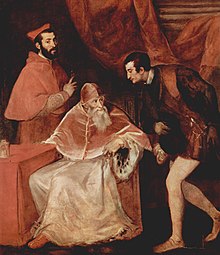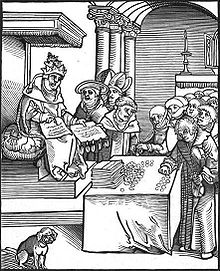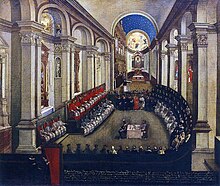Reformation Papacy
This article has multiple issues. Please help improve it or discuss these issues on the talk page. (Learn how and when to remove these template messages)
|

The discipline and administration of the Latin Church underwent important changes from 1517 to 1585 during and Counter-Reformation, specifically at the Council of Trent.
History
Reformation

The institution of the
Along with Luther,
- In calling the pope the "antichrist," the early Lutherans stood in a tradition that reached back into the eleventh century. Not only dissidents and bishop of Rome the "antichrist" when they wished to castigate his abuse of power.[5]
The four most important traditions to emerge directly from the reformation were the
Smalcald Articles, Article four (1537)
- ...the Pope is the very Antichrist, who has exalted himself above, and opposed himself against Christ because he will not permit Christians to be saved without his power, which, nevertheless, is nothing, and is neither ordained nor commanded by God. This is, properly speaking to exalt himself above all that is called God as Paul says, 2 Thess. 2, 4. Even the Tartars, great enemies of Christians as they are, do not do this, but they allow whoever wishes to believe in Christ, and take bodily tribute and obedience from Christians... Therefore, just as little as we can worship the devil himself as Lord and God, we can endure his apostle, the Pope, or Antichrist, in his rule as head or lord. For to lie and to kill, and to destroy body and soul eternally, that is wherein his papal government really consists... The Pope, however, prohibits this faith, saying that to be saved a person must obey him. This we are unwilling to do, even though on this account we must die in God's name. This all proceeds from the fact that the Pope has wished to be called the supreme head of the Christian Church by divine right. Accordingly he had to make himself equal and superior to Christ, and had to cause himself to be proclaimed the head and then the lord of the Church, and finally of the whole world, and simply God on earth, until he has dared to issue commands even to the angels in heaven...[6]
Treatise on the Power and Primacy of the Pope (1537)
- ...Now, it is manifest that the Roman pontiffs, with their adherents, defend [and practice] godless doctrines and godless services. And the marks [all the vices] of Antichrist plainly agree with the kingdom of the Pope and his adherents. For Paul, in describing Antichrist to the heathen kings, and he calls this one the adversary of Christ, because he will devise doctrine conflicting with the Gospel, and will assume to himself divine authority...[7]
- 25.6. There is no other head of the Church but the Lord Jesus Christ: nor can the Pope of Rome in any sense be head thereof; but is that Antichrist, that man of sin and son of perdition, that exalts himself in the Church against Christ, and all that is called God.[8]
Counter-Reformation
The Catholic Church did not mount an organized and deliberate response to the Protestant Reformation until the election (1534) of Pope Paul III, who placed the papacy itself at the head of a movement for churchwide reform. Pope Paul III established a reform commission, appointed several leading reformers to the College of Cardinals, initiated reform of the central administrative apparatus at Rome, authorized the founding of the Jesuits, the order that was later to prove so loyal to the papacy, and convoked the Council of Trent, which met intermittently from 1545 to 1563. The council succeeded in initiating a number of far-ranging moral and administrative reforms, including reform of the papacy itself, that was destined to define the shape and set the tone of Roman Catholicism into the mid-20th century.[citation needed]
Such reforms included the foundation of

But while the basic structure of the Church was reaffirmed, there were noticeable changes to answer complaints that the Counter Reformers tacitly were willing to admit were legitimate. Among the conditions to be corrected by Catholic reformers was the growing divide between the priests and the flock; many members of the
Thus, the Council of Trent was dedicated to improving the discipline and administration of the Church. The worldly excesses of the
The Council, by virtue of its actions, repudiated the pluralism of the Secular Renaissance Church: the organization of religious institutions was tightened, discipline was improved, and the parish was emphasized. The appointment of Bishops for political reasons was no longer tolerated. In the past, the large landholdings forced many bishops to be "absent bishops" who at times were property managers trained in administration. Thus, the Council of Trent combated "
The reign of
While the aggressive
The Papacy of
Aftermath
The pontificate of Pope Sixtus V (1585–1590) opened up the final stage of the Catholic Reformation characteristic of the Baroque age of the early seventeenth century, shifting away from compelling to attracting. His reign focused on rebuilding Rome as a great European capital and Baroque city, a visual symbol for the Catholic Church.[citation needed]
Notes
- ^ Mullett 2015, p. 281.
- ^ Luther's Works, page 38
- ^ Wilson 2007, p. 282; See on this, Hillerbrand 2007, p. 53.
- ^ Calvin, John (1536). "Of the Beginning and Rise of the Romish Papacy, Till It Attained a Height by Which the Liberty of the Church Was Destroyed, and All True Rule Overthrown". Institutes of the Christian Religion. Translated by Henry Beveridge. Edinburgh: Calvin Translation Society (published 1845). Book 4, Chapter 7.
- ^ See Building Unity, edited by Burgess and Gross
- ^ Smalcald Articles, Article 4 in the Triglot translation of the Book of Concord
- ^ Treatise on the Power and in the Triglot translation of the Book of Concord
- ^ Col. 1:18; Matt. 28:18–20; Eph. 4:11–12; 2 Thess. 2:2–9
- ^ Franzen, August (1969) [1965]. John P. Dolan (ed.). A History of the Church. Translated by Peter Becker. New York: Herder and Herder. pp. 308, 333.
- ^ Franzen 1969, p. 333.
Bibliography
- Hillerbrand, Hans Joachim (2007). The Division of Christendom. Louisville: Westminster John Knox Press. p. 53.
- Mullett, Michael A. (2015). Martin Luther. Abingdon and New York: Routledge. p. 281.
- Wilson, Derek (2007). The life and legacy of Martin Luther. Random House. p. 282.
